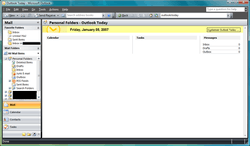Microsoft Outlook
.svg.png) | |
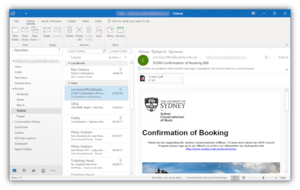 An email inbox in Outlook 2019, running on Windows 10 | |
| Developer(s) | Microsoft Corporation |
|---|---|
| Stable release |
1612 (Build 7668.2074)
/ January 31, 2017[1] |
| Operating system | Microsoft Windows |
| Type | Personal information manager |
| License | Trialware |
| Website |
www |
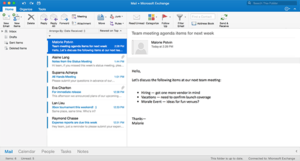 Outlook for Mac 2016 | |
| Developer(s) | Microsoft Corporation |
|---|---|
| Stable release | |
| Operating system | macOS |
| Type | Personal information manager |
| License | Proprietary commercial software |
| Website |
www |
Microsoft Outlook is a personal information manager from Microsoft, available as a part of the Microsoft Office suite. Although often used mainly as an email application, it also includes a calendar, task manager, contact manager, note taking, journal, and web browsing.
It can be used as a stand-alone application, or can work with Microsoft Exchange Server and Microsoft SharePoint Server for multiple users in an organization, such as shared mailboxes and calendars, Exchange public folders, SharePoint lists, and meeting schedules. Microsoft has also released mobile applications for most mobile platforms, including iOS and Android. Developers can also create their own custom software that works with Outlook and Office components using Microsoft Visual Studio.[3] In addition, Windows Phone devices can synchronize almost all Outlook data to Outlook Mobile.
Versions
Microsoft Outlook has replaced Microsoft's previous scheduling and mail programs, Schedule+ and Exchange Client.
Versions of Microsoft Outlook include:
| Name | Version Number[4] | Release Date[5] | Notes |
|---|---|---|---|
| Outlook for MS-DOS | - | 1992 [6] | Bundled with Exchange Server 5.5 |
| Outlook for Windows 3.1x[7] | - | 1992 [6] | Bundled with Exchange Server 5.5 |
| Outlook for Macintosh | - | - | Bundled with Exchange Server 5.5 |
| Outlook 97 | 8.0 | January 16, 1997 | Included in Office 97 and bundled with Exchange Server 5.5 |
| Outlook 98 | 8.5 | June 21, 1998 | Freely distributed with books and magazines for coping with then newest Internet standard such as HTML mail.[8] Outlook 98 setup was based on Active Setup which also installed Internet Explorer 4.[9] |
| Outlook 2000 | 9.0 | June 27, 1999 | Included in Office 2000 and bundled with Exchange 2000 Server. |
| Outlook 2002 | 10 | May 31, 2001 | Included in Office XP |
| Office Outlook 2003 | 11 | November 20, 2003 | Included in Office 2003 (incl. Standard Edition for Students and Teachers) and bundled with Exchange Server 2003 |
| Office Outlook 2007 | 12 | January 27, 2007 | Included in Office 2007, except Office Home and Student edition |
| Outlook 2010 | 14 | July 15, 2010 | Included in Office 2010 Home and Business, Standard, Professional and Professional Plus |
| Outlook 2011 for Mac | 14 | October 26, 2010 | Included in Office for Mac 2011 Home and Business |
| Outlook 2013 | 15 | January 29, 2013 | Included in Office 2013, except Home & Student edition |
| Outlook for Mac | 15.3 | October 31, 2014 | Included in Office 365, except some commercial editions |
| Outlook for Phones & Tablets | 1.3 | 2015 | Included in Office 365, except some commercial editions
Includes IOS (Apple O/S) and Android (Google O/S) Support |
| Outlook 2016 | 16 | September 22, 2015 | Included in Office 365 |
Outlook 98 and Outlook 2000 offer two configurations:
- Internet Mail Only or IMO mode: A lighter application mode with specific emphasis on POP3 accounts and IMAP accounts and including a lightweight Fax application.
- Corporate Workgroup or CW mode: A full MAPI client with specific emphasis on Microsoft Exchange accounts.
Microsoft Windows
Outlook 2002
Outlook 2002 introduced the following new features:[10]
- AutoComplete for email addresses
- Colored categories for calendar items
- Group schedules
- Hyperlink support in email subject lines
- Native support for Outlook.com (formerly Hotmail)
- Improved search functionality including the ability to stop a search and resume it later
- Lunar calendar support
- MSN Messenger integration
- Performance improvements[11]
- Preview pane improvements including the ability to open hyperlinks; respond to meeting requests; and display email properties without opening a message
- Reminder window that consolidates all reminders for appointments and tasks in a single view
- Retention policies for documents and email
- Security improvements including the automatic blocking of potentially unsafe attachments and of programmatic access to information in Outlook
- SP1 introduced the ability to view all non-digitally signed email or unencrypted email as plain text[12]
- SP2 allows users to—through the Registry—prevent the addition of new email accounts or the creation of new Personal Storage Tables[13]
- SP3 updates the object model guard security for applications that access messages and other items[14]
- Smart tags when Word is configured as the default email editor
Outlook 2003
Outlook 2003 introduced the following new features:[15]
- AutoComplete suggestions for a single character
- Cached Exchange mode
- Colored (quick) flags
- Desktop Alert
- Email filtering to combat spam
- Images in HTML mail are blocked by default to prevent spammers from determining whether an email address is active via web beacon[16]
- SP1 introduced the ability to block email based on country code top-level domains[17]
- SP2 introduced anti-phishing functionality that automatically disables hyperlinks present in spam[18]
- Expandable distribution lists
- Information rights management
- Intrinsic support for tablet PC functionality (e.g., handwriting recognition)
- Reading pane
- Search folders
- Unicode support
Outlook 2007
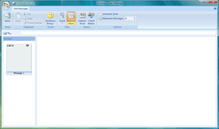
Features that debuted in Outlook 2007 include:[19]
- Attachment preview, with which the contents of attachments can be previewed before opening
- Supported file types include Excel, PowerPoint, Visio, and Word files. If Outlook 2007 is installed on Windows Vista, then audio and video files can be previewed. If a compatible PDF reader such as Adobe Acrobat 8.1 is installed, PDF files can also be previewed.[20]
- Auto Account Setup, which allows users to enter a username and password for an email account without entering a server name, port number, or other information
- Calendar sharing improvements including the ability to export a calendar as an HTML file—for viewing by users without Outlook—and the ability to publish calendars to an external service (e.g., Office Web Apps) with an online provider (e.g., Microsoft account)
- Colored categories with support for user roaming, which replace colored (quick) flags introduced in Outlook 2003[21]
- Improved email spam filtering and anti-phishing features
- Postmark intends to reduce spam by making it difficult and time consuming to send it
- Information rights management improvements with Windows Rights Management Services and managed policy compliance integration with Exchange Server 2007
- Japanese Yomi name support for contacts
- Multiple calendars can be overlaid with one another to assess details such as potential scheduling conflicts
- Ribbon (Office Fluent) interface
- Outlook Mobile Service support, which allowed multimedia and SMS text messages to be sent directly to mobile phones[22]
- Instant search through Windows Search, an index-based desktop search platform
- Instant search functionality is also available in Outlook 2002 and Outlook 2003 if these versions are installed alongside Windows Search[23]
- Integrated RSS aggregation
- Support for Windows SideShow with the introduction of a calendar gadget[24]
- To-Do Bar that consolidates calendar information, flagged email, and tasks from OneNote 2007, Outlook 2007, Project 2007, and Windows SharePoint Services 3.0 websites within a central location.
- The ability to export items as PDF or XPS files
- Unified messaging support with Exchange Server 2007 with features such as missed call notifications, and voicemail with voicemail preview with Windows Media Player[24]
- Word 2007 replaces Internet Explorer as the default viewer for HTML email[21]
Outlook 2010
Features that debuted in Outlook 2010 include:[25]
- Additional command-line switches
- An improved conversation view that groups messages based on different criteria regardless of originating folders
- IMAP messages are sent to the Deleted Items folder, eliminating the need to mark messages for future deletion
- Notification when email is about to be sent without a subject
- Quick Steps, individual collections of commands that allow users to perform multiple actions simultaneously
- Ribbon interface in all views
- Search Tools contextual tab on the ribbon that appears when performing searches and that includes basic or advanced criteria filters
- Social Connector to connect to various social networks and aggregate appointments, contacts, communication history, and file attachments
- Spell check in additional areas of the user interface
- Support for multiple Exchange accounts in a single Outlook profile
- The ability to schedule a meeting with a contact by replying to an email message
- To-Do Bar enhancements including visual indicators for conflicts and unanswered meeting requests
- Voice mail transcripts for Unified Messaging communications
- Zooming user interface for calendar and mail views
Outlook 2013
Features that debuted in Outlook 2013, which was released on January 29, 2013, include:
- Attachment reminder
- Exchange ActiveSync(EAS)
- Add-in resiliency
- Cached Exchange mode improvements
- IMAP improvements
- Outlook data file(.ost) compression
- People hub
- Startup performance improvements
Outlook 2016
Features that debuted in Outlook 2016, include:[26]
- Attachment link to cloud resource
- Groups redesign
- Search cloud
- Clutter Folder
- Email Address Internationalization
- Scalable Vector Graphics
Macintosh
Microsoft also released several versions of Outlook for classic Mac OS, though it was only for use with Exchange servers. It was not provided as a component of Microsoft Office for Mac, but instead made available to users from administrators or by download. The final version was Outlook for Mac 2001, which was fairly similar to Outlook 2000 and 2002 apart from being exclusively for Exchange users.
Microsoft Entourage was introduced as an Outlook-like application for Mac OS in Office 2001, but it lacked Exchange connectivity. Partial support for Exchange server became available natively in Mac OS X with Entourage 2004 Service Pack 2. Entourage is not directly equivalent to Outlook in terms of design or operation; rather, it is a distinct application which has several overlapping features including Exchange client capabilities. Somewhat improved Exchange support was added in Entourage 2008 Web Services Edition.
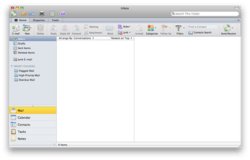
Entourage was replaced by Outlook for Mac 2011, which features greater compatibility and parity with Outlook for Windows than Entourage offered. It is the first native version of Outlook for macOS.
Outlook 2011 initially supported Mac OS X's Sync Services only for contacts, not events, tasks or notes. It also does not have a Project Manager equivalent to that in Entourage.[27] With Service Pack 1 (v 14.1.0), published on April 12, 2011, Outlook can now sync calendar, notes and tasks with Exchange 2007 and Exchange 2010.
On October 31, 2014, Microsoft released Outlook for Mac (v15.3 build 141024) with Office 365 (a software as a service licensing program that makes Office programs available as soon as they are developed). Outlook for Mac 15.3 improves upon its predecessors with:[28]
- Better performance and reliability as a result of a new threading model and database improvements.
- A new modern user interface with improved scrolling and agility when switching between Ribbon tabs.
- Online archive support for searching Exchange (online or on-premises) archived mail.
- Master Category List support and enhancements delivering access to category lists (name and color) and sync between Mac, Microsoft Windows and OWA clients.
- Office 365 push email support for real-time email delivery.
- Faster first-run and email download experience with improved Exchange Web Services syncing.[28]
iOS and Android
Outlook for phones and tablets
In January 2015, Microsoft released Outlook for phones and for tablets (v1.3 build) with Office 365.[29] This was the first Outlook for these platforms with email, calendar, and contacts.
Internet standards compliance
HTML rendering
Outlook 2007 was the first Outlook to switch from Internet Explorer rendering engine to Microsoft Word 2007's. This means HTML and CSS items not handled by Word are no longer supported. On the other hand, HTML messages composed in Word look as they appeared to the author.[30] This affects publishing newsletters and reports, because they frequently use intricate HTML and CSS to form their layout. For example, forms can no longer be embedded in email.
Support of CSS properties and HTML attributes
Outlook for Windows has very limited CSS support compared to various other e-mail clients. Neither CSS1 (1996) nor CSS2 (1998) specifications are fully implemented and many CSS properties can only to be used with certain HTML elements for the desired effect.[31] Some HTML attributes help achieve proper rendering of e-mails in Outlook, but most of these attributes are already deprecated in the HTML 4.0 specifications (1997).[32] In order to achieve the best compatibility with Outlook, most HTML e-mails are created using multiple boxed tables, as the table element and its sub-elements support the width and height property in Outlook. No improvements have been made towards a more standards-compliant email client since the release of Outlook 2007.[33]
Transport Neutral Encapsulation Format
Outlook and Exchange Server internally handle messages, appointments and items as objects in a data model which is derived from the old proprietary Microsoft Mail system, the Rich Text Format from Microsoft Word and the complex OLE general data model.[34] When these programs interface with other protocols such as the various Internet and X.400 protocols, they try to map this internal model onto those protocols in a way that can be reversed if the ultimate recipient is also running Outlook or Exchange.[35]
This focus on the possibility that emails and other items will ultimately be converted back to Microsoft Mail format is so extreme that if Outlook/Exchange cannot figure out a way to encode the complete data in the standard format, it simply encodes the entire message/item in a proprietary binary format called Transport Neutral Encapsulation Format (TNEF) and sends this as an attached file (usually named "winmail.dat") to an otherwise incomplete rendering of the mail/item. If the recipient is Outlook/Exchange it can simply discard the incomplete outer message and use the encapsulated data directly, but if the recipient is any other program, the message received will be incomplete because the data in the TNEF attachment will be of little use without the Microsoft software for which it was created.[35] As a workaround, numerous tools for (partially) decoding TNEF files exist.[36]
Calendar compatibility
Outlook does not fully support data and syncing specifications for calendaring and contacts, such as iCalendar, CalDAV, SyncML, and vCard 3.0. Outlook 2007 claims to be fully iCalendar compliant; however, it does not support all core objects, such as VTODO or VJOURNAL.[37] Also, Outlook supports vCard 2.1 and does not support multiple contacts in the vCard format as a single file. Outlook has also been criticized for having proprietary "Outlook extensions" to these Internet standards.
Security concerns
As part of its Trustworthy Computing initiative, Microsoft took corrective steps to fix Outlook's reputation in Office Outlook 2003. Among the most publicized security features are that Office Outlook 2003 does not automatically load images in HTML emails or permit opening executable attachments by default, and includes a built-in Junk Mail filter.[38] Service Pack 2 has augmented these features and adds an anti-phishing filter.[39]
Outlook add-ins
Outlook add-ins are small helping programs for the Microsoft Outlook application. The main purpose of the add-ins is to add new functional capabilities into Microsoft Outlook and automate some routine operations. The term also refers to programs where the main function is to work on Outlook files, such as synchronization or backup utilities. Outlook add-ins may be developed in Microsoft Visual Studio or third-party tools such as Add-in Express. Outlook add-ins are not supported in Outlook Web App.
From Outlook 97 on, Exchange Client Extensions are supported in Outlook. Outlook 2000 and later support specific COM components called Outlook AddIns. The exact supported features (such as .NET components) for later generations were extended with each release.
SalesforceIQ Inbox for Outlook
In March 2016, Salesforce announced that its relationship intelligence platform, SalesforceIQ, would be able to seamlessly integrate with Outlook.[40] SalesforceIQ works from inside the Outlook inbox providing data from CRM, email and customer social profiles. It also provides recommendations within the inbox on various aspects like meeting scheduling, contacts, responses etc.
Hotmail Connector
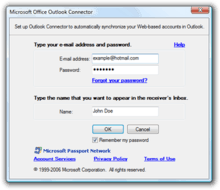
Microsoft Outlook Hotmail Connector (formerly Microsoft Office Outlook Connector), is a discontinued and defunct free add-in for Microsoft Outlook 2003, 2007 and 2010, intended to integrate Outlook.com (formerly Hotmail) into Microsoft Outlook. It uses DeltaSync, a proprietary Microsoft communications protocol that Hotmail formerly used.[41]
In version 12, access to tasks and notes and online synchronization with MSN Calendar is only available to MSN subscribers of paid premium accounts. Version 12.1, released in December 2008 as an optional upgrade, uses Windows Live Calendar instead of the former MSN Calendar. This meant that calendar features became free for all users, except for tasks synchronization which became unavailable. In April 2008, version 12.1 became a required upgrade to continue using the service as part of a migration from MSN Calendar to Windows Live Calendar.[42]
Microsoft Outlook 2013 and later have intrinsic support for accessing Outlook.com and its calendar over the Exchange ActiveSync (EAS) protocol,[43] while older versions of Microsoft Outlook can read and synchronize Outlook.com emails over the IMAP protocol.[44]
Social Connector
Outlook Social Connector was a free add-in for Microsoft Outlook 2003 and 2007 by Microsoft that allowed integration of social networks such as Facebook, Linkedin and Windows Live Messenger into Microsoft Outlook.[45] It was first introduced in November 18, 2009.[46] Starting with Microsoft Office 2010, Outlook Social Connector is an integral part of Outlook.[47]
CardDAV and CalDAV Connector
Since Microsoft Outlook does not support CalDAV and CardDAV protocol along the way, various 3rd-party software vendors developed Outlook add-ins to enable users synchronizing with CalDAV and CardDAV servers. CalConnect has a list[48] of software that enable users to synchronize their calendars with CalDAV servers/contacts with CardDAV servers.
Importing from other email clients
Traditionally, Outlook supported importing messages from Outlook Express and Lotus Notes. In addition, Microsoft Outlook supports POP3 and IMAP protocols, enabling users to import mails from servers that support these protocols, such as Gmail or Rackspace Email. Microsoft Hotmail Connector add-in (described above) helps importing email from Hotmail accounts. Outlook 2013 later integrated the functionality of this add-in and added the ability to import email (as well as calendar) through Exchange ActiveSync protocol.[43]
There are some ways to get the emails from Thunderbird; the first is to use a tool[49] that can convert a Thunderbird folder to a format that can be imported from Outlook Express. This method must be processed folder by folder. The other method is to use a couple of free tools that keep the original folder structure.[50] If Exchange is available, an easier method is to connect the old mail client (Thunderbird) to Exchange using IMAP, and upload the original mail from the client to the Exchange account.
See also
References
- ↑ "Office 365 client update branch releases". TechNet. Microsoft. Retrieved January 12, 2016.
- ↑ "Description of the security update for Office 2016 for Mac: July 12, 2016". Microsoft. July 12, 2016. Retrieved July 25, 2016.
- ↑ "Top 10 Reasons to Use Outlook". PCWorld. February 10, 2009.
- ↑ The version numbers follows the Office numbers.
- ↑ "Microsoft Outlook Life-cycle Information". Retrieved October 23, 2011.
- 1 2 https://prezi.com/3lrn5b1odmtn/everything-you-wanted-to-know-about-outlook/
- ↑ "XCLN: Microsoft Outlook for Windows 3.1x". Support.microsoft.com. August 18, 2005. Retrieved February 24, 2013.
- ↑ HTML Mail with Microsoft Outlook
- ↑ OL98: How to Troubleshoot Active Setup Problems in Windows 98, 98 SE or ME
- ↑ "Microsoft Outlook 2002 Product Guide". Microsoft. May 30, 2001. Archived from the original (DOC) on February 7, 2003. Retrieved December 31, 2017.
- ↑ "Microsoft Outlook 2002 Performance Tuning". Microsoft. June 7, 2001. Archived from the original (DOC) on October 4, 2003. Retrieved December 31, 2017.
- ↑ "OL2002: Users Can Read Nonsecure E-mail as Plain Text". Support. Microsoft. Archived from the original on October 20, 2004. Retrieved December 31, 2017.
- ↑ Mosher, Sue (August 26, 2002). "Office XP SP2 Brings Changes to Outlook". Windows IT Pro. Penton. Archived from the original on January 1, 2018. Retrieved January 1, 2018.
- ↑ Mosher, Sue (March 25, 2004). "Tighter Security in Outlook 2002 SP2". Windows IT Pro. Penton. Archived from the original on January 1, 2018. Retrieved January 1, 2018.
- ↑ "Microsoft Office 2003 Editions Product Guide". Microsoft. September 2003. Archived from the original (DOC) on November 4, 2005. Retrieved March 5, 2017.
- ↑ Harkins, Susan (April 22, 2008). "How do I... Avoid e-mail spam using Outlook tools?". TechRepublic. CBS Interactive. Archived from the original on December 24, 2013. Retrieved January 2, 2018.
- ↑ Rist, Oliver (August 20, 2004). "You have nothing to fear from Office 2003 SP1". InfoWorld. IDG. Archived from the original on December 31, 2017. Retrieved December 31, 2017.
- ↑ Yegulalp, Serdar. "Microsoft Office 2003 SP2's antiphishing filter for Outlook". SearchExchange. TechTarget. Retrieved December 31, 2017.
- ↑ "What's new in Microsoft Office Outlook 2007". Support. Microsoft. Archived from the original on January 23, 2010. Retrieved January 3, 2018.
- ↑ Bruzzese J., Peter (February 4, 2008). "Outlook 2007 vs. Outlook 2003". Windows IT Pro. Penton. Archived from the original on January 3, 2018. Retrieved January 3, 2018.
- 1 2 "Discontinued features and modified functionality in Outlook 2007". Support. Microsoft. Archived from the original on December 27, 2009. Retrieved January 3, 2018.
- ↑ "Outlook Mobile Service - How it works? Advantages? Features?". MSDN. Microsoft. April 9, 2008. Archived from the original on January 2, 2018. Retrieved January 3, 2018.
- ↑ Posey, Brian (April 21, 2009). "How Windows Desktop Search works in Microsoft Outlook 2007". SearchExchange. TechTarget. Archived from the original on September 27, 2010. Retrieved January 3, 2017.
- 1 2 Byrne, Randy; Gregg, Ryan (2007). "Chapter 2: Outlook as a Platform". MSDN. Microsoft. Archived from the original on January 3, 2018. Retrieved January 3, 2018.
- ↑ "What's new in Microsoft Outlook 2010". Support. Microsoft. Archived from the original on March 11, 2016. Retrieved January 3, 2017.
- ↑ "What's new in Outlook 2016 for Windows".
- ↑ Welsh, John C. (October 1, 2010). "Microsoft Outlook for Mac 2011". Macworld. IDG. Retrieved November 7, 2010.
- 1 2 "New Outlook for Mac available to Office 365". Office Blogs. Microsoft. October 31, 2014. Retrieved November 1, 2014.
- ↑ Compare: "Office on iOS and Android". Office Blogs. Microsoft. January 29, 2015. Retrieved January 11, 2015.
- ↑ "Microsoft Outlook 2007 Report | Email Standards Project". email-standards.org. Retrieved February 24, 2013.
- ↑ "CSS Support Guide for Email Clients – Campaign Monitor".
- ↑ "HTML 4.0 Specification".
- ↑ "A designer's guide to Outlook 2013 and Office 365".
- ↑ Outlook Data Model Reference (page on the MailItem object class members), MSDN development documentation, , retrieved May 2011
- 1 2 Preface of the TNEF specification, Outlook 2010 edition, , retrieved May 2011
- ↑ See list of some TNEF decoders in the main TNEF article
- ↑ "Microsoft Office 2003 editions comparison". Microsoft. Retrieved October 3, 2008.
- ↑ "Microsoft Outlook 2003: Using Junk E-mail Filters". uwec.edu. University of Wisconsin-Eau Claire.
- ↑ "Microsoft Internet Safety and Security Center". Microsoft.
- ↑ Miller, Ron. "Salesforce-Microsoft love grows with SalesforceIQ-Outlook integration | TechCrunch". Retrieved 2017-09-04.
- ↑ "Microsoft Office Outlook Hotmail Connector overview". Microsoft Office website. Microsoft. Archived from the original on 28 January 2013.
- ↑ "Transition information for former Office Live Small Business customers – Manage Office 365 – Office 365 – Microsoft Office 365 Community". Ask.officelive.com. Retrieved June 15, 2013.
- 1 2 "What's new in Outlook 2013". TechNet Library. Microsoft. December 11, 2012. Retrieved March 1, 2013.
- ↑ "Add your Outlook.com account in Outlook for Windows". Office Support. Microsoft. Retrieved 27 June 2017.
- ↑ Thomas, Doug (August 24, 2010). "How to install the Outlook Social Connector (video)". Office Casual blog. Microsoft. Retrieved March 1, 2013.
- ↑ "Announcing the Outlook Social Connector". Outlook Blog. Microsoft. November 18, 2009. Retrieved March 1, 2013.
- ↑ "Changes in Outlook 2010 (for IT pros)". TechNet Library. Microsoft. November 27, 2012. Retrieved March 1, 2013.
- ↑ "CalDAV Clients". Archived from the original on May 23, 2016.
- ↑ "IMAPSize".
- ↑ "Export messages and folders from Thunderbird to Outlook / Outlook Express / Windows Mail".
